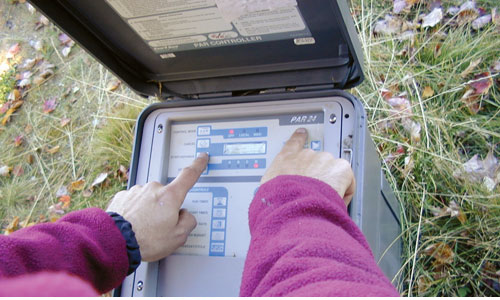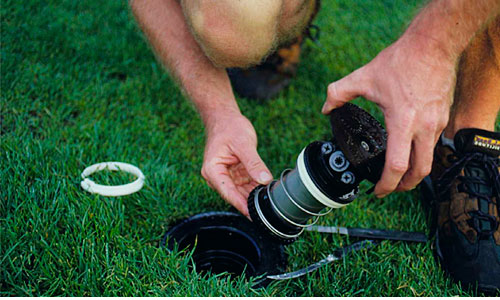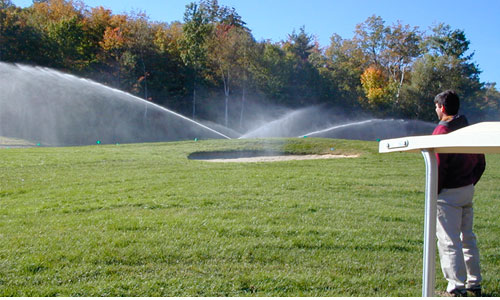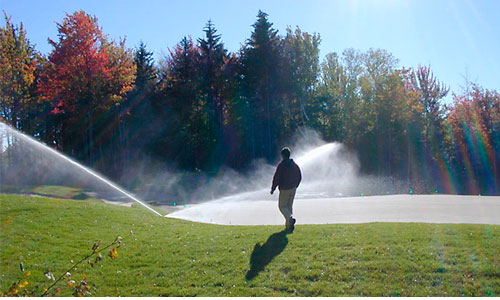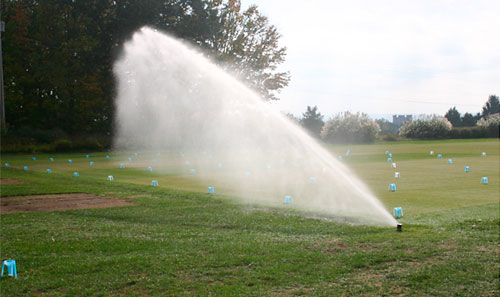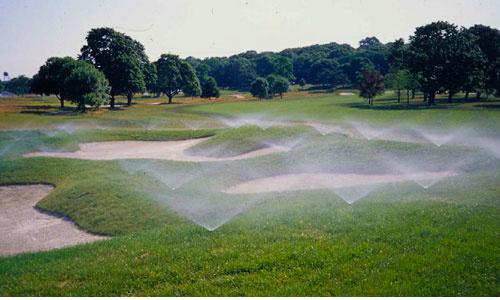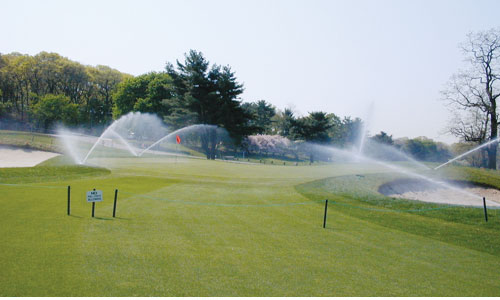Irrigation systems should be designed to be efficient, distribute water uniformly, conserve and protect water resources, meet state and local code, and meet site requirements. Once designed, they must work properly to provide efficient irrigation.
Design
Irrigation systems should be designed to be efficient, distribute water uniformly, conserve and protect water resources, meet state and local code, and meet site requirements. Site specific characteristics and incorporation of water conservation practices and technologies should be evaluated in the design. The Irrigation Association lists 25 design-oriented BMPs. Several examples of irrigation site-specific designs to conserve water are shown below.
Site Considerations
The design and operation of an irrigation system must be tailored to conditions on the course. Planning should account for different soil types, areas of irrigation, and turf species. Soil conditions dictate how much water is needed to complete deep and infrequent cycles to replenish water in the root zone. The areas of irrigation may also vary in their water requirements depending on site characteristics such as aspect to the sun, hill slopes, and degree of shade. For example, wind-exposed areas have greater transpiration losses than sheltered areas and therefore greater water requirements.
Infrastructure
Infrastructure design considerations include sprinkler and piping placement, sprinkler coverage and spacing, and communication options and serviceability. An irrigation system must be designed to match peak demand. The capacity to deliver more water in a short interval of time can be increased up to, but not exceeding, the infiltration rates of the soils. Any increase beyond the infiltration rate results in runoff.
The type of system used for irrigation influences the efficiency and effectiveness of water usage. Single head systems irrigate the areas closest to the head more than areas farther out. The difference in distribution uniformity presents a serious problem, as achieving planned water replacement on the outer reaches of the head results in excess water being applied in the middle and increases the risk of runoff. Double-row systems offer an improved efficiency over single-row coverage, although manual watering or other types of supplemental watering may be needed outside the fairway area and into the extended rough. Multi-row sprinkler systems provide the best method to control and conserve water, with the ability to respond to specific moisture requirements of a given fairway area. In addition, newer designs are available with multiple nozzle configurations, back and front, that provide the flexibility to more precisely size the system and improve distribution uniformity.
Advanced irrigation control systems are recommended when possible because they provide precision irrigation control. These systems provide specific schedules for each green, tee, and fairway and allow course managers to make adjustments for differences in microclimates and root zones. Weather stations can be integrated to calculate and automatically program water replacement schedules. Additional features may include rain stop safety switches that either shut down the system in the event of rain or adjust schedules based on the amount of precipitation. Advanced systems can connect soil moisture meters, temperatures gauges, and salinity probes installed on the course.
Performance
Properly working systems are necessary for efficient irrigation. Irrigation audits can be conducted to assess the system function, ensuring that the irrigation system works reliably and cost effectively. The Irrigation Association has published irrigation audit guidelines (http://www.irrigation.org/Resources/Audit_Guidelines.aspx). The following are common measures of system performance used in irrigation audits:
Coefficient of Uniformity (CU). CU measures system performance by how widely a system varies in distribution. A CU of 100% means that a system is uniform. A CU of 84% or better is considered acceptable for high value products. Because the CU is calculated with the absolute value of the deviations, the score does not indicate whether the system is over- or under-watering. In addition, the score does not indicate what section of the area tested is not performing.
Distribution Uniformity of the Lowest Quartile (DULQ). The most commonly used calculation to determine uniformity of a sprinkler layout, DULQ is the ratio of the average measurements in the lowest 25% of samples to the overall average of all samples expressed as a percentage. For example, a DULQ of 60% means that the lowest 25% of the samples measured only received 60% of the average water applied. Some resources suggest that a DULQ of 65% or less is poor, 75% is good, and 85% or more is excellent.
Scheduling Coefficient (SC): measures the average water applied to the driest, most critical areas of an area under test and compares to the average. An SC of 100% implies the distribution is uniform. An SC of 120 % indicates that the average was 120% more water applied than the driest area. The SC is often used to adjust run times to ensure that the driest areas receive the required scheduled water replacement. The disadvantage of this method is that all other areas receive 20% too much water, increasing the risk of runoff and leaching.
